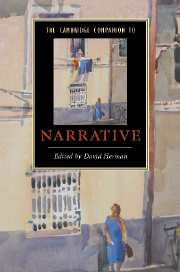5 - Character
from Part II - Studying narrative fiction: a starter-kit
Published online by Cambridge University Press: 28 September 2007
Summary
In the widest sense, “character” designates any entity, individual or collective - normally human or human-like - introduced in a work of narrative fiction. Characters thus exist within storyworlds, and play a role, no matter how minor, in one or more of the states of affairs or events told about in the narrative. Character can be succinctly defined as storyworld participant.
Now, for its part, the storyworld itself divides into the spheres of narration and of the narrated, the telling and what is told about. “Character” in the narrower sense is restricted to participants in the narrated domain, the narrative agents. Characters are introduced in the text by means of three kinds of referring expressions: proper names (including letters and numbers), such as Don Quixote; definite descriptions, such as the knight of mournful countenance; and personal pronouns (I, she). Names and definite descriptions occurring in a given work often originate with it, hence introducing original fictions, or occur already in earlier works by the same author or by others, thereby yielding new versions of the original fiction, or pick out an actual person, thus yielding a literary, sometimes highly fictionalized, version of the real individual.
- Type
- Chapter
- Information
- The Cambridge Companion to Narrative , pp. 66 - 79Publisher: Cambridge University PressPrint publication year: 2007
- 36
- Cited by

